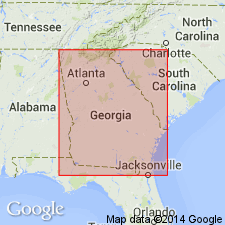
- Usage in publication:
-
- Oconee Group
- Modifications:
-
- Named
- Dominant lithology:
-
- Sand
- AAPG geologic province:
-
- South Georgia sedimentary province
Summary:
The name Oconee Group is formally proposed in this report to include all of the pre-upper Eocene, or pre-Barnwell Group kaolin and kaolinitic sand deposits of fluvial origin in the Fort Valley plateau and Fall Line Hills districts of the Coastal Plain of central GA. Named units within the group are the "Tuscaloosa formation" of western GA, the Pio Nono Formation (new), the Cape Fear Formation, the Gaillard Formation (new), the Middendorf Formation, and the Huber Formation. The Fort Valley Group, also named in this report, includes the temporally equivalent kaolin and kaolinitic sand deposits of coastal marine origin. The Oconee of this report is equivalent to the Lower Cretaceous of Veatch and Stephenson (1911); the Middendorf Formation of Cooke (1926); and the Tuscaloosa Formation of Cooke (1936) and later workers. The outcrop belt extends from eastern AL eastward through SC into NC. The formations within the Oconee are closely related and are characterized by prominent stratification, with horizontal- and undulatory-bedding, cross-bedding, and thin to thick bedding. Sorting throughout is moderate to poor, with rare, well sorted sands. Sediments are fine- to coarse-grained and pebbly or gravelly, finely to coarsely micaceous, kaolinitic, and pale gray to white or brightly pigmented. Dominant lithic component is quartz sand, but small to large lenticular masses of micaceous, sand, to relatively pure kaolin, and small to large lenses of variably carbonaceous and lignitic sands and clays also occur locally. Maximum thickness is estimated at 1000 ft. Unconformably overlies Piedmont metamorphic rocks or Triassic Newark Group. Age ranges from Late Cretaceous to middle Eocene.
Source: GNU records (USGS DDS-6; Reston GNULEX).
For more information, please contact Nancy Stamm, Geologic Names Committee Secretary.
Asterisk (*) indicates published by U.S. Geological Survey authors.
"No current usage" (†) implies that a name has been abandoned or has fallen into disuse. Former usage and, if known, replacement name given in parentheses ( ).
Slash (/) indicates name conflicts with nomenclatural guidelines (CSN, 1933; ACSN, 1961, 1970; NACSN, 1983, 2005, 2021). May be explained within brackets ([ ]).

